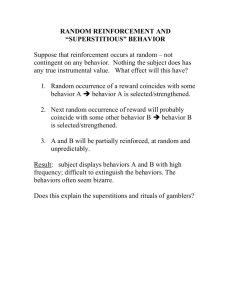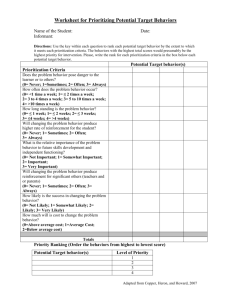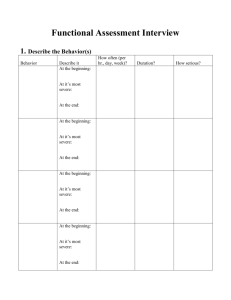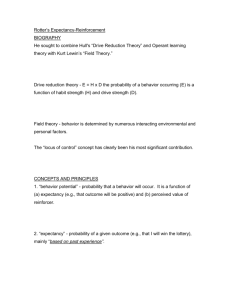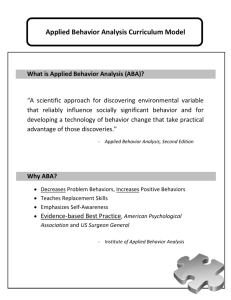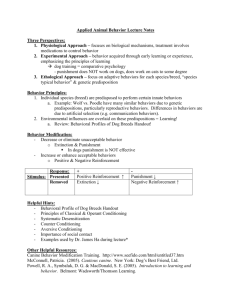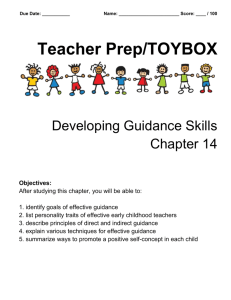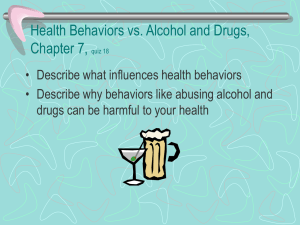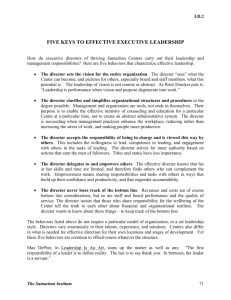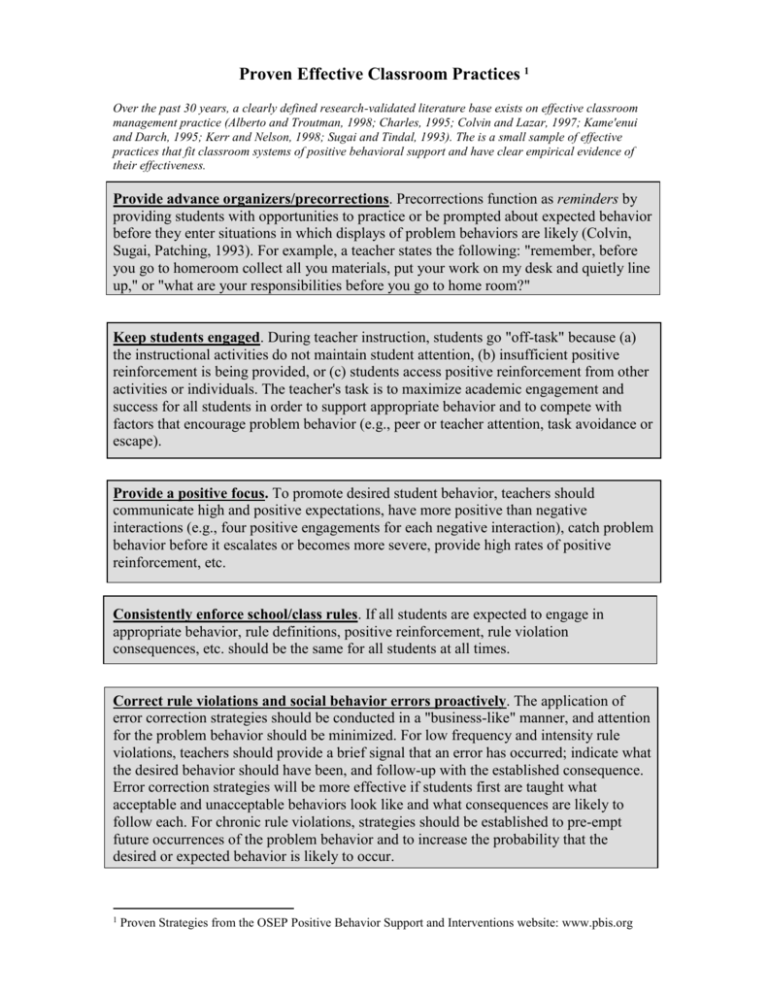
Proven Effective Classroom Practices 1
Over the past 30 years, a clearly defined research-validated literature base exists on effective classroom
management practice (Alberto and Troutman, 1998; Charles, 1995; Colvin and Lazar, 1997; Kame'enui
and Darch, 1995; Kerr and Nelson, 1998; Sugai and Tindal, 1993). The is a small sample of effective
practices that fit classroom systems of positive behavioral support and have clear empirical evidence of
their effectiveness.
Provide advance organizers/precorrections. Precorrections function as reminders by
providing students with opportunities to practice or be prompted about expected behavior
before they enter situations in which displays of problem behaviors are likely (Colvin,
Sugai, Patching, 1993). For example, a teacher states the following: "remember, before
you go to homeroom collect all you materials, put your work on my desk and quietly line
up," or "what are your responsibilities before you go to home room?"
Keep students engaged. During teacher instruction, students go "off-task" because (a)
the instructional activities do not maintain student attention, (b) insufficient positive
reinforcement is being provided, or (c) students access positive reinforcement from other
activities or individuals. The teacher's task is to maximize academic engagement and
success for all students in order to support appropriate behavior and to compete with
factors that encourage problem behavior (e.g., peer or teacher attention, task avoidance or
escape).
Provide a positive focus. To promote desired student behavior, teachers should
communicate high and positive expectations, have more positive than negative
interactions (e.g., four positive engagements for each negative interaction), catch problem
behavior before it escalates or becomes more severe, provide high rates of positive
reinforcement, etc.
Consistently enforce school/class rules. If all students are expected to engage in
appropriate behavior, rule definitions, positive reinforcement, rule violation
consequences, etc. should be the same for all students at all times.
Correct rule violations and social behavior errors proactively. The application of
error correction strategies should be conducted in a "business-like" manner, and attention
for the problem behavior should be minimized. For low frequency and intensity rule
violations, teachers should provide a brief signal that an error has occurred; indicate what
the desired behavior should have been, and follow-up with the established consequence.
Error correction strategies will be more effective if students first are taught what
acceptable and unacceptable behaviors look like and what consequences are likely to
follow each. For chronic rule violations, strategies should be established to pre-empt
future occurrences of the problem behavior and to increase the probability that the
desired or expected behavior is likely to occur.
1
Proven Strategies from the OSEP Positive Behavior Support and Interventions website: www.pbis.org
Teach and plan for smooth transitions. Teachers should never assume students would
know what behaviors are expected during transitions. Successful transitions are
associated with (a) teaching clear expectations for student behavior, (b) establishing clear
expectations for staff behavior during transitions, (c) preplanning transition
implementation, (d) following transition routines consistently, and (e) providing regular
and frequent acknowledgements for successful transitions.
Teach and plan for smooth transitions. Teachers should never assume students would
know what behaviors are expected during transitions. Successful transitions are
associated with (a) teaching clear expectations for student behavior, (b) establishing clear
expectations for staff behavior during transitions, (c) preplanning transition
implementation, (d) following transition routines consistently, and (e) providing regular
and frequent acknowledgements for successful transitions.
Suggested Learning Activities
Hand out list of strategies for transitioning. Have staff identify which strategies they
could use. Have them list strategies at appropriate place in lesson plans.
Lead staff in a brainstorming of ideas for creating smooth transitions. Hand out list
of strategies and note how many they had already identified. Review the new items.
Have teachers share at their tables which new strategies they might use.
Check back in subsequent staff meeting to see how they are doing.
Classroom Routines
(From Temple Teacher’s Connection www.temple.edu/CETP/temple_teach)
Establishing clear expectations for student behavior is the primary purpose for setting up
classroom routines. If students are familiar with the processes necessary to get a
particular job done, they are more likely to complete it in an orderly manner. Develop
plans for these activities that work for your physical space and your management style. If
a routine is not effective, you can involve your students in redesigning the routine.
Movement
Develop plans for entering and exiting the classroom and changing class
configurations, such as moving from whole class to small-group
instruction. Also plan for movement of individual students to meet needs
such as pencil sharpening and getting personal supplies.
This includes activities such as taking attendance, collecting permission
slips, making participation counts (pretzels, extracurricular activities)
Non-instruction
and keeping the classroom neat. When allowable, students can assist
tasks
with these tasks. Some of these tasks can be used as instructional
activities.
Materials
Management
If routines are developed for the distribution, collection and storage of
instructional materials, student helpers will be able to complete them
quickly.
Transitions
If instructional materials are prepared and organized, transitions between
activities will be smooth and take little time. Necessary materials might
be listed on the daily schedule so students will know what they need and
can prepare for one activity as materials for the previous activity are
stored or collected.
Group Work
Each team member within a group should have a job, and over time each
student should have an opportunity to do each job. Develop job
descriptions and routines for assigning the jobs. Jobs might be
facilitator, time-keeper, reporter, recorder, encourager, questioner,
materials manager, taskmaster -- make up your own or use one of the
many plans that have been developed.
Preventing Behavior Problems During Transitions and
“Challenging Times” of the School Day
Contents of this article are excerpted from:
Rief, S. The ADHD Book of Lists. San Francisco, CA: JosseyBass (a Wiley publication), 2003.
Classroom transitions:
Clearly communicate verbally or with visuals when activities will begin and when they will
end
Give specific instructions about how they are to switch to the next activity
Be sure to clearly teach, model, and have students practice and rehearse all procedures
that will occur in changes of activities. This includes such things as the students’ quick
and quiet movement from their desks to the carpet area, putting away/taking out
materials, and so forth.
Use signals for transitions (e.g. playing a bar of music on a keyboard, flashing lights,
ringing a bell, beginning a clapping pattern, prompts such as “1,2,3…eyes on me”)
A signal indicates that an activity is coming to an end and children need to finish
whatever they are doing
Some teachers signal and tell students they will have a brief amount of time (3-5 minutes)
to finish what they are working on before the next activity, or to clean up. They then set a
timer for that amount of time.
Primary grade teachers typically use songs or chants for transitions (e.g., for cleaning up,
moving to the rug)
Provide direct teacher guidance and prompting to those students who need it during
transitions
Reward smooth transitions. Many teachers use individual points or table points to reward
students or rows/table clusters of students who are ready for the next activity. The
reward is typically something simple like being the first row or table to line up for recess
Be organized in advance with prepared materials for the next activity
Transitioning from out-of-classroom activities back to the
classroom:
It is helpful for teachers to meet their students after lunch, PE, recess, and other activities
outside of the classroom – and walk them quietly into the classroom
Set a goal for the class (e.g., everyone enters class after lunch/recess and is quiet and
ready to work by a certain time). On successful days of meeting that goal, the class is
rewarded by a move on a behavior chart. See Connect the Dots chart as an example in
the Appendix
Use relaxation and imagery activities or exercises for calming after recess, lunch, and
P.E. Playing music, singing, and/or reading to students at these times is also often
effective
Out-of-classroom school settings:
Teach, model, and practice appropriate behaviors and expectations for out-of-classroom
activities (e.g., in the cafeteria, passing in hallways, during assemblies)
Assign a buddy or peer helper to assist during these transitional periods and out-ofclassroom times
It is important to have school wide rules/behavioral expectations so that all staff members
calmly and consistently enforce through positive and negative consequences
School wide incentives and positive reinforcers (e.g., "caught being good tickets”
redeemable for school prizes) are helpful in teaching and motivating appropriate
behaviors outside of the classroom
For students who have behavioral difficulty on the bus, an individual contract or including
the bus behavior on a Daily Report Card should be arranged (with the cooperative efforts
of the school, bus driver, and parent)
Special contracts or some type of individualized behavior plan with incentives for
appropriate behavior may need to be arranged for the playground, cafeteria, or other
such times of the day. See List 2-9: Individualized Behavior Management, Interventions,
and Support and Appendix for examples of various contracts and DRCs
If using a Daily Report Card or monitoring form of some type), no reports of behavioral
referrals in out-of-classroom settings for the day can result in bonus points on the report
card
Increase supervision outside of the classroom, and provide more choices of activities that
children can engage in (e.g., hula hoops, jump rope, board games, library/computer,
supervised games)
It is important that all staff are aware of the struggles children with ADHD have in nonstructured environments. Awareness training of ADHD should be provided for personnel
involved with supervision outside of the classroom
Staff members should identify and positively target those students in need of extra
support, assistance, and careful monitoring outside of the classroom
Increase supervision during passing periods, lunch, recess, and school arrival/dismissal
It is helpful to have organized clubs and choices for students before and after school, and
during the break before/after lunch
© 2000 SandraRief.com
All Rights Reserved
Provide advance organizers/precorrections. Precorrections function as reminders by
providing students with opportunities to practice or be prompted about expected
behavior before they enter situations in which displays of problem behaviors are likely
(Colvin, Sugai, Patching, 1993). For example, a teacher states the following:
"remember, before you go to homeroom collect all you materials, put your work on my
desk and quietly line up," or "what are your responsibilities before you go to home
room?"
Suggested Learning Activities
Review the 7-step process for pre-correction in the article attached. Group staff in
pairs or small groups based on a student with a behavior problem that they all know.
Instruct pairs or groups to talk through the steps of the process for their particular
student.
Review the 7-step pre-correction plan for entering after recess. Form small groups,
identify problematic times and establish a 7-step plan. Report back if time allows.
Precorrection: An instructional approach for managing predictable
problem behaviors
Colvin, G., Sugai, G., & Patching, B., (1993). Precorrection: An instructional
approach for managing predictable problem behaviors. Intervention in
School and Clinic, 28(3), 143-150. Copyright (1993) by PRO-ED, Inc.
Adapted and reprinted electronically with permission.
A preventive approach to solving problem behaviors has several possible
outcomes:
1. Serious problem behavior may be prevented.
2. Students who have been labeled at risk may be directed towards
functioning at levels considered to be more appropriate.
3. The behavior of students without disabilities may be strengthened
and occasions for modeling may be increased.
4. Improvement in the behavior may be maintained.
Teachers are faced with having to manage a variety of behaviors in a
variety of settings, such as in the classroom, on the playground, in p.e.,
etc. Reactive techniques which occur after the behavior has been
exhibited may be ineffective in controlling the problems. By manipulating
the antecedents and consequences of the behavior, a new appropriate
behavior can take the place of the inappropriate behavior. Teachers can,
in turn, become proactive to situations instead of being reactive and can
be more effective in solving behavior problems.
Several basic assumptions underlie the use of precorrection procedures.
First, both appropriate and inappropriate behaviors are learned.
And as such, appropriate behaviors can be taught.
Second, students can learn through the systematic manipulation of
teacher input (antecedents) and teacher output (consequences).
When students make academic errors, the teacher adjusts
instruction accordingly to remediate deficits. The same can be done
for behavior problems. Teachers can arrange instruction to correct
errors in behavior.
There is a difference in precorrection versus correction techniques. Using
correction techniques an error or problem occurs and feedback is given.
There is information given about the correct response and there is an
opportunity for the student to practice the response. There is
reinforcement for cooperation.
For example, if a student enters the classroom loudly after recess the teacher could
remind him to enter the room quietly. He could be asked to go back to the door and try it
again. Once he has successfully followed the directions, the teacher would praise him for
entering the room quietly.
A behavior has occurred and the teacher reacts to it. Unfortunately, this
procedure does not always prove to be effective.
Precorrection techniques involve a strategy which can be broken down in
seven steps.
Step 1: Identify the Context and the Predictable Behavior.
The context can be any event, task, condition, circumstance or any
other antecedent which occasions the behavior on some basis. In
the example given above, the context would be the transition time
from recess back to the classroom and the predictable behavior
would be the noisy entry of the student. The context can be
identified formally through a functional analysis where an observer
takes notes on the antecedents to the behavior ( i.e. teacher giving
directions), what the behaviors are (i.e. student making faces at
neighbor) and what the consequences are (i.e. the other student
yells back and disrupts the class). Or the context and behavior can
be identified informally through observations, discussions with other
personnel, or a survey of educational records.
Step 2: Specify the Expected Behavior.
In order to do this, you may want to consider:
1. the expected behavior in observable terms (i.e. instead of
pays attention, try watches the teacher)
2. select a behavior that is incompatible with the problem
behavior (i.e. if he is watching you, he can't be looking at his
neighbor)
3. select expected behaviors that are functional replacements
for the problem behavior (i.e. watching the teacher versus
going to the office)
Step 3: Modify the Context.
You want to increase the likelihood that the behavior will occur and
decrease the likelihood that the inappropriate behavior will occur.
Modifications can be made for example in instructions given,
activities, seating arrangements, etc. The least obtrusive
modifications should be used at first moving to more restrictive
modifications as needed.
For example, before beginning instruction, the teacher may use a signal to gain
the attention of the students. Or, if Susan and Harry pick on each other, then a
change in seating could solve the problem.
Step 4: Conducting Behavior Rehearsals.
This training should occur just before the student enters the target
context. This training may take several forms. The student can be
asked to recall the appropriate behavior, model the behavior, or
keep a checklist as a reminder of the behavior. The assumption is
that the student is more likely to remember the expected behaviors
if training occurs just prior to the target context.
Step 5: Provide Strong Reinforcement for Expected Behaviors.
It may be difficult to establish a new pattern of behavior if the old
pattern has been utilized over a period of time. The new behavior
will be in competition with the old behavior and strong
reinforcement may be needed for replacement to occur.
Remember, reinforcement is only reinforcement if the behavior
increases; it depends on the individual.
Step 6: Prompting Expected Behavior.
Students may need additional assistance in order to display the
appropriate behavior. You may want to:
1. acknowledge the student immediately after the expected
behavior is exhibited.
2. provide a reminder of the behavior within the context of the
lesson (i.e. "Who can raise his or her hand and tell me what
the capitol of Florida is?").
3. use correction procedures:
1. For the first occurrence of the inappropriate behavior,
try ignoring it.
2. For the second occurrence of the inappropriate
behavior, use a 2 part signal to correct the behavior.
For example, if the student is talking out, try placing your finger
on your lips as the signal for quiet and raise your hand to model
the appropriate behavior.
3. For the third occurrence present a warning of the
target behavior. Present this warning as a choice.
For example, you could say "If you have a comment or a
question, you need to raise your hand. If you choose to speak
out, you will lose 5 minutes of free time."
Step 7: Monitoring the Plan.
Data should be collected to see if the plan is working. Is the
inappropriate behavior decreasing and the appropriate behavior
increasing? Monitoring the plan as the teacher may be difficult to do
with all the other responsibilities of the job. Peers have been used
as monitors successfully, or aides, practicum students, and even
volunteers could be called on for monitoring.
This article contains examples of Precorrection Checklists and Plans.
Going down the page are rectangular boxes which specify each area such
as context, predictable behavior, expected behavior, context modification,
behavior rehearsal, strong reinforcement, prompts, and monitoring plan.
Your input is written within the box describing each of these steps. This
checklist can be used as an aid in implementing such a plan and can be
useful for the documentation of behaviors. Although the article describes
situations involving a single student, I believe this procedure could also be
implemented for classwide difficulties.
Pre-Correction
Checklist and Plan
1. Content
2. Predictable Behavior
3. Expected Behavior
4. Context Modification
5. Behavior Rehearsal
6. Strong Reinforcement
7. Prompts
8. Monitoring Plan
Teacher_________________
Student_________________
Date____________________
Students entering classroom immediately after recess.
Enter shouting, laughing, and pushing before complying
with teacher direction.
Enter room quietly, go to desks, begin task, keep hands to
self.
Teacher meets students at door, has them wait and then go
to desk to begin entry tasks.
Teacher reminds students just before recess of expected
behaviors. Asks students to tell what expected behaviors
are.
Students are told that if they cooperate with teacher
requests, they will have additional breaks and 5 extra
minutes for recess.
Teacher gives signal at the door to be quiet and points to
activity on chalkboard. Teacher says “hush” to noisy
students and praises students who are beginning to work.
Teacher uses a watch to measure how long it takes for all
students to get on task and counts how many students begin
their tasks immediately (within 10 seconds)
Keep students engaged. During teacher instruction, students go "off-task" because
(a) the instructional activities do not maintain student attention, (b) insufficient
positive reinforcement is being provided, or (c) students access positive reinforcement
from other activities or individuals. The teacher's task is to maximize academic
engagement and success for all students in order to support appropriate behavior and
to compete with factors that encourage problem behavior (e.g., peer or teacher
attention, task avoidance or escape).
Suggested Learning Activities
Review or hand out the attached list. Hand out index cards to each staff (each card
lists one strategy from the list). Have each person consider a how to use the strategy
on their card. Share in small groups. (This can be done in small groups instead of
individually if preferred.)
Hand out and review the attached list. Group staff by the strategy they are most
likely to use. Have each group consider how to use the strategy. Report back to
large group.
Suggestions for designing more engaging in-class activities and
increasing the amount of time students spend on task.
1. Ensure course materials relate to students' lives and highlight ways
learning can be applied in real-life situations (Lumsden, 1994; Skinner
& Belmont, 1991). Schoolwork should be meaningful to students outside
the school building, as well as within. Students are more engaged in
activities when they can build on prior knowledge and draw clear
connections between what they are learning and the world they live in.
They also need to feel that "school work is significant, valuable, and
worthy of their efforts" (Policy Studies Associates, 1995).
2. Allow students to have some degree of control over learning (Brooks et
al., 1998). This can be done in any number of ways, from giving students
choices between different assignments, to minimizing adult supervision
over group projects, to letting students monitor and evaluate their own
progress (Anderman & Midgley, 1998; Dev, 1997; Policy Studies
Associates, 1995). Anderman & Midgely (1998) note that this doesn't
mean teachers must relinquish control of the classroom: "Even small
opportunities for choice, such as whether to work with a partner or
independently" (p. 3) give students a greater sense of autonomy.
3. Assign challenging but achievable tasks for all students, including atrisk, remedial, and learning disabled students. Tasks that seem
impossible easily discourage learners, as do those tasks that are rote and
repetitive (Dev, 1997; Policy Studies Associates, 1995). Remedial
programs that limit students to repetitive basic skills activities actually
"prompt students' lack of engagement in their schoolwork and frequently
result in limited achievement" (Policy Studies Associates, 1995).
Students need to feel successful and that they've earned success.
4. Arouse students' curiosity about the topic being studied. Strong, Silver,
and Robinson (1995) suggest using the "mystery" approach, in which
students are presented with fragmentary or contradictory information
about a subject and are then asked to examine available evidence to
develop their own hypotheses. This kind of activity also builds on
students' needs for competence and autonomy, giving students an
opportunity to direct inquiry and "discover for themselves."
5. Design projects that allow students to share new knowledge with others.
Strong, Silver & Robinson (1995) observe that when students do
assignments that only the teacher will read, they are entering into a
nonreciprocal relationship. More often than not, the teacher already
knows and has no real need for the information the student is providing
him or her. Projects are more engaging when students share what they
are learning in reciprocal relationships, as in collaborative projects where
each student's knowledge is needed by others in the group to complete an
assignment.
6. Ensure course materials relate to students' lives and highlight ways
learning can be applied in real-life situations (Lumsden, 1994; Skinner
& Belmont, 1991). Schoolwork should be meaningful to students outside
the school building, as well as within. Students are more engaged in
activities when they can build on prior knowledge and draw clear
connections between what they are learning and the world they live in.
They also need to feel that "school work is significant, valuable, and
worthy of their efforts" (Policy Studies Associates, 1995).
7. Allow students to have some degree of control over learning (Brooks et
al., 1998). This can be done in any number of ways, from giving students
choices between different assignments, to minimizing adult supervision
over group projects, to letting students monitor and evaluate their own
progress (Anderman & Midgley, 1998; Dev, 1997; Policy Studies
Associates, 1995). Anderman & Midgely (1998) note that this doesn't
mean teachers must relinquish control of the classroom: "Even small
opportunities for choice, such as whether to work with a partner or
independently" (p. 3) give students a greater sense of autonomy.
8. Assign challenging but achievable tasks for all students, including atrisk, remedial, and learning disabled students. Tasks that seem
impossible easily discourage learners, as do those tasks that are rote and
repetitive (Dev, 1997; Policy Studies Associates, 1995). Remedial
programs that limit students to repetitive basic skills activities actually
"prompt students' lack of engagement in their schoolwork and frequently
result in limited achievement" (Policy Studies Associates, 1995).
Students need to feel successful and that they've earned success.
9. Arouse students' curiosity about the topic being studied. Strong, Silver,
and Robinson (1995) suggest using the "mystery" approach, in which
students are presented with fragmentary or contradictory information
about a subject and are then asked to examine available evidence to
develop their own hypotheses. This kind of activity also builds on
students' needs for competence and autonomy, giving students an
opportunity to direct inquiry and "discover for themselves."
10. Design projects that allow students to share new knowledge with others.
Strong, Silver & Robinson (1995) observe that when students do
assignments that only the teacher will read, they are entering into a
nonreciprocal relationship. More often than not, the teacher already
knows and has no real need for the information the student is providing
him or her. Projects are more engaging when students share what they
are learning in reciprocal relationships, as in collaborative projects where
each student's knowledge is needed by others in the group to complete an
assignment.
Provide a positive focus. To promote desired student behavior, teachers should
communicate high and positive expectations, have more positive than negative
interactions (e.g., four positive engagements for each negative interaction), catch
problem behavior before it escalates or becomes more severe, provide high rates of
positive reinforcement, etc.
Suggested Learning Activities
Ask staff how they know what kids find reinforcing. Suggest creating a survey.
Review the list of ideas attached. Have staff brainstorm additional items for the list.
Give staff 10 minutes of the scheduled staff meeting time to go onto their computers
and go to the following website and create a student reinforcer survey.
http://www.jimwrightonline.com/php/jackpot/jackpot.php
(This website allows the user to create personalized reinforcer surveys)
Collect the sample surveys as staff enter the meeting room. Share their experience.
Hand out the list of ways to verbally reinforce. Challenge staff to identify 10 of the
phrases they will use. Send or post reminders to use the verbal reinforcers. Check
back at the next staff meeting. Have staff describe their experience using the
phrases.
Classroom Incentive Ideas
Karaoke
Games
Sports
Movie day
No Homework Pass
Free time
Picnic lunches (outside)
Lunch with staff member
Lunch with friend
Teacher helper
Shadow a staff member
Help with morning announcements
Be a mentor or peer buddy
Additional center time
“hat day” (allow hats)
Take care of class animal
Move desk to chosen place
Operate projector
Be first to eat
Join another class for activity
Phone parents
Choose music for class
100 Ways to Verbally Reinforce
1. SUPER GOOD!
2. You've got it made.
3. SUPER!
4. That's RIGHT.
5. That's good.
6. You're really working hard today.
7. You are very good at that.
8. That's coming along nicely.
9. GOOD WORK!
10.That's much better.
11.I'm happy to see you working like that.
12.Exactly right.
13.I'm proud of the way you worked today.
14.You are doing that much better today.
15.You've just about got it.
16.That's the best job you've ever done.
17.You're doing a good job.
18.THAT'S IT!
19.Now you've figured it out.
20.That's quite an improvement.
21.GREAT!
22.I knew you could do it.
23.Congratulations!
24.You're making real progress.
25.Keep working on it. You're improving.
26.Now you have it!
27.You are learning fast.
28.EXTRAORDINARY!
29.Couldn't have done it better myself.
30.You are a joy.
31.One more time and you have it.
32.You really make my job fun.
33.That's the right way to do it.
34.You're getting better every day.
35.You did it that time.
36.You're on the right track.
37.Nice going.
38.You haven't missed a thing.
39.WOW!
40.That's the right way.
41.Keep up the good work.
42.TERRIFIC!
43.Nothing can stop you now.
44.That's the way to do it.
45.SENSATIONAL!
46.You've got your brain in gear.
47.That's better.
48.That was first class work.
49.EXCELLENT!
50.That's the best ever.
51.You've just about mastered that.
52.PERFECT!
53.That's better than ever.
54.Much better!
55.WONDERFUL!
56.You must have been practicing.
57.You did that very well.
58.FINE!
59.Nice going.
60.You're really going to town.
61.OUTSTANDING!
62.FANTASTIC!
63.TREMENDOUS!
64.That's how to handle it!
65.Now that's what I call a fine job.
66.That's great.
67.Right on!
68.You're really improving.
69.You're doing beautifully.
70.Superb!
71.Good remembering!
72.You've got that down pat.
73.You certainly did well today.
74.Keep it up!
75.Congratulations - you did it!
76.You did a lot of work today.
77.Well, look at you go!
78.That's it!
79.I'm very proud of you.
80.MARVELOUS!
81.I like that.
82.Way to go!
83.Now you have the hang of it.
84.You're doing fine.
85.Good thinking.
86.You are really learning a lot.
87.Good going.
88.I've never seen anyone do it better.
89.Keep on trying!
90.You outdid yourself today.
91.Good for you!
92.I think you've got it now.
93.That's wonderful!
94.Good job.
95.You figured that out fast.
96.You remembered!
97.That's really nice.
98.That kind of work makes me happy.
99.It's such a pleasure to work with you.
100. ____________________
Consistently enforce school/class rules. If all students are expected to engage in
appropriate behavior, rule definitions, positive reinforcement, rule violation
consequences, etc. should be the same for all students at all times.
Suggested Learning Activities
If you don’t have classroom rules that are aligned with school-wide expectations,
spend time creating rules (see school-wide training binder for guidelines)
If you have classroom rules, have staff team up to find creative ways to review the
rules daily. Report back to the group.
If teachers have unique sets of classroom rules, consider having them complete the
classroom behavior management plan attached. Provide a sample completed form
and review. Have them provide a copy for the PBS Team to ensure they follow rule
development guidelines and are consistent with school-wide expectations. This
form also asks teachers to identify how they will teach the rules, identify common
classroom procedures, how they will reinforce appropriate behaviors, and how they
will handle inappropriate behaviors.
Florida’s Positive Behavior Support Project Proven Effective Classroom Practices 73
Classroom Rules
1. Teach and review school-wide rules daily.
2. Create, teach and review classroom rules. Classroom rules should be positive, unique
to classroom needs, but related to the school-wide expectations. They should be based on
the problem behaviors you see in the classroom (rules should reflect what you want to see
“instead” of the problem behavior) and should be based the specific skills and procedures
that you want students to engage in and perform while in the classroom.
Sample Classroom Rules:
Mr. Jones’
Class
Mrs. Lee’s
Class
Be Safe
Sit with your chair
on all 4 legs
Walk
Be
Responsible
Bring your
materials to class
each day
Bring your
homework every
day
Be
Respectful
Keep your hands
and feet to yourself
Use appropriate
language
Talk when it is
your turn to talk
Ask if it is “OK” to
borrow an item
Use the Classroom Behavior Management Plan form to organize classroom rules and
procedures.
Florida’s Positive Behavior Support Project Proven Effective Classroom Practices 74
Classroom Behavior Management Plan
Classroom Rules (3-5 Positively Stated Observable Behaviors)
Teaching the Rules (How you will teach, when you will teach-initial and booster, how you will remind
students, etc..)
Classroom Procedures (daily routine, when to sharpen pencils, turn in homework, get a hall pass, etc)
Positive Reinforcement (in addition to Dog Dollars, how will your recognize appropriate behavior)
Negative Consequences: Step Plan (system for dealing with students who don’t follow rules and
procedures
Florida’s Positive Behavior Support Project Proven Effective Classroom Practices 75
Florida’s Positive Behavior Support Project Proven Effective Classroom Practices 76
Correct rule violations and social behavior errors proactively. The application of error
correction strategies should be conducted in a "business-like" manner, and attention for
the problem behavior should be minimized. For low frequency and intensity rule
violations, teachers should provide a brief signal that an error has occurred; indicate what
the desired behavior should have been, and follow-up with the established consequence.
Error correction strategies will be more effective if students first are taught what
acceptable and unacceptable behaviors look like and what consequences are likely to
follow each. For chronic rule violations, strategies should be established to pre-empt
future occurrences of the problem behavior and to increase the probability that the desired
or expected behavior is likely to occur.
Suggested Learning Activities
Share the attached list of classroom interventions (ways to respond to inappropriate
behaviors). Ask teachers to add to the list any strategies they use that are not listed.
Have administrator look for teachers using and reinforce staff that use these
strategies with students.
Share strategies for avoiding escalation of behavior. Role-play a situation between a
student and teacher modeling wrong and right way of responding. Team up staff to
practice role-playing.
Florida’s Positive Behavior Support Project Proven Effective Classroom Practices 77
Classroom Interventions
Clarification – Clarification is used as an initial intervention when, undesirable
behaviors first occur, when student needs to be reminded of expectations, or when
teacher is not sure of cause of misbehavior. Clarification interventions should be brief,
concise, and not reflect emotions or judgment. Clarification interventions should be used
only once for each occurrence; this prevents “preaching” and communicates to student
the need for a meaningful response (if response is not meaningful – more restrictive
interventions will be used).
Reinforcement of Others – The use of praise or earned rewards to reinforce the
appropriate behaviors of other students in the classroom will often cue the misbehaving
student of the teacher’s expectations. It is important that the targeted students do not
view that you are punishing them at this time but helping to cue them into their behavior.
Reinforcement should be made available to the targeted student when they are displaying
the desired behavior.
Proximity Control – This intervention involves the teacher/paraprofessionals moving
closer to the misbehaving student. Often the teacher’s proximity to the student is enough
to stop the behavior.
Signal Interference – These are non-verbal techniques such as eye-contact, hand
gestures, facial frowns, and body posture which communicate information to the student.
Redirection – Distract the student, change the focus of the activity the child is currently
engaged in, especially effective with younger and/or developmentally delayed students,
although appropriate for all (i.e. “help me out; go get me the red pen off the desk”)
Premac Principle (Grandma’s Law) – You work before you play. “As soon as
you_____ you can _____” (i.e. beat the timer; give yourself 5 earned points as soon as
you do 2 problems; you may have this M&M as soon as you finish the first row)
Planned Ignoring – Sometimes it is wise for the teacher to ignore a student’s behavior,
assuming that it will not spread to others and that the student will soon discontinue it and
return his/her attention to learning
Interest Boosting- If the student’s interest in an activity is waning; it is sometimes
helpful for the teacher to show interest in the student’s assignment. This often results in
helping the student to mobilize his efforts in an attempt to please the teacher.
Curricular Modifications – Important first step when students are exhibiting behaviors
resulting from frustration with the curriculum.
Examples: shortened assignments, break large tasks into segments,
provide a different medium for doing the same lesson, provide a peer
tutor, give 1-on-1 assistance, restate or rephrase directions
Florida’s Positive Behavior Support Project Proven Effective Classroom Practices 78
Avoiding Escalating Behavior and Power Struggles
Para verbal Communication: Look at the way you are communicating with the
students whose behavior is beginning to escalate. Here are some helpful hints:
Tone: Avoid impatient and angry, used empathetic and sympathetic
understanding
Volume: Make sure it is appropriate for the distance between you and the
student, and the situation
Cadence: Deliver message using even rhythms
Do’s
1. Make sure you have eye contact
Don’ts
1. Show Fear
2. Listen carefully
2. Over/under react
3. Give appropriate personal space
3. Argue or confront
4. Remain Calm
4. Not follow through
5. Safety, be aware of environment
5. Make false promises
6. Be alert
6. Threaten
7. Be consistent and focused
7. Use jargon, buzz words
8. Enforce limits
8. Use “right’ or “wrong”
9. Remain in control
10. Use “ok” and “not ok”
Empathetic Listening: Ways to let your students know that you are “truly” listening
to their concerns. Here are some helpful hints:
Use an active process: making eye contact, nodding your head
Be non-judgmental
Allow for silence
Listen for hidden message
Give undivided attention
(Crisis Prevention Institute, Inc. 1987)
Florida’s Positive Behavior Support Project Proven Effective Classroom Practices 79
Miscellaneous Classroom Resources
Florida’s Positive Behavior Support Project Proven Effective Classroom Practices 80
Effective Teaching Profile
Place an X on the scale to indicate the extent to which the teacher displayed the best teaching
practices. Connect each X to display a teaching profile.
Yes______No 1. Brisk pacing
Yes______No 2. Specific explanations and instructions for new concepts
Yes______No 3. Allocated time for guided practice
Yes______No 4. Cumulative review of skills being taught
Yes______No 5. Regularly varied assessments of learning of new concepts
Yes______No 6. Regular and active interactions with individual students
Yes______No 7. Frequent and detailed feedback
Yes______No 8. Varied forms of positive reinforcement
Yes______No 9. Positive, predictable, and orderly learning environment
Yes______No 10. Maintenance of student attention within and across instructional activities
and materials
Yes______No 11. Reinforcement for task completion
Yes______No 12. Appropriate selection of examples and nonexamples
Yes______No 13. Consistent application of contingencies for rules and expectations
Yes______No 14. Appropriate use of model/demonstrations
Yes______No 15. Appropriate use of behavior rehearsal (role- plays)
Yes______No 16. Smooth transition within and between lessons
Yes______No 17. High rates of correct student responding.
Florida’s Positive Behavior Support Project Proven Effective Classroom Practices 81
12 Required Social Skills for a “Compliant” Student
Studies have found that students who are seen as “defiant”, resulting in being referred to the office
on a referral are lacking one or of more of the following social skills. These students need direction
instruction on the “How To” for each of the skills listed below. (Dowd & Tierney, 1992; West
&Young 1994a, 1994b; Young & West 1995; Peterson & Peterson & Lacy, 2003)
1. Follow Instructions: not only needed for the social aspects of the class but also for
the academic components
2. Getting the Teacher’s Attention: varies from class to class, how do students get
attention in your classroom?
3. Accepting “No” for an Answer: students are usually expected to accept “no” as an
answer without responding back
4. Accepting Feedback: can be in regards to a student’s behavior and/or a needed
correction on an assignment 5. How to Disagree Appropriately: most students have
difficulty telling the teacher that they disagree and why
5. How to Make a Request: students may assume the answer will be “no”, so they
don’t ask or do so in a manner that will lead to “no”
6. How to Make a Decision: students don’t know the steps to making a sound decision
7. How to Resist Peer Pressure: students don’t know how to say “no” to their peers
and want to “save face”
8. How to Negotiate: if students don’t know how to disagree appropriately, then they
will struggle with compromising
9. How to Respond to Teasing: we tell students all the time to “ignore” their peers, but
do we really teach them how? Also, kids “blow up” after they ignore a peer and it
doesn’t go away right away-we need to let our students know it will get worse before it
gets better
10. How to Deal with an Accusation: students become very defensive when accused
of something, whether they are guilty or not, making it hard for them to share their side
of the story
11. How to Apologize: students need to learn when to say, “I’m sorry” and how to do
it with sincerity, which will show that they care about others
Florida’s Positive Behavior Support Project Proven Effective Classroom Practices 82
Florida’s Positive Behavior Support Project Proven Effective Classroom Practices 83

